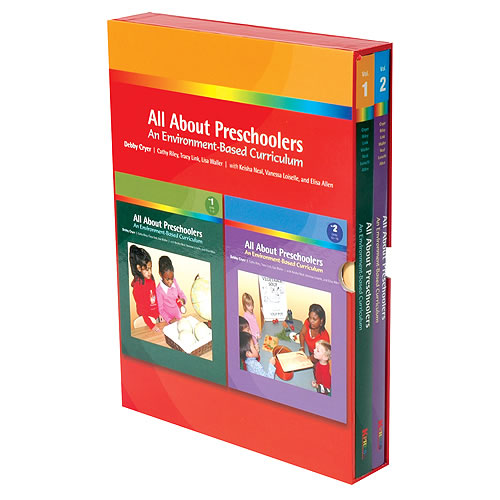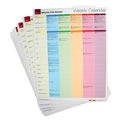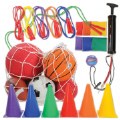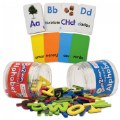All About Preschoolers, 2nd Edition - 2 Book Set
From the developers of All About the ECERS-R, All About Preschoolers is a carefully designed curriculum program for preschool classrooms where children are accepted for what they can do at the time when they can do it, and are moved through the prerequisites for abstract learning (academics) that will come when each is old enough and ready to efficiently learn what is required with little failure.
Based on Years of Research
The
Grounded in ECERS-R
It is likely that, if the curriculum is carried out with reasonable faith to what is written, any classroom would receive high scores on the Early Childhood Environment Rating Scale (ECERS-R) because the authors carefully considered the requirements of the scale as they designed All About Preschoolers.
Where to Use It
All About Preschoolers is meant to be used in preschool classrooms, where the majority of children are 4-year-olds. If 3-year-olds are included in the preschool, the more flexibility and individualized experiences should be provided for them. It can also be used in kindergartens because of the open-ended, individualized approach taken with children.
Who Can Use It
With over 600 photographs depicting the use of the curriculum in the classroom environment, All About Preschoolers can be used by any preschool teaching staff, including experienced and new teachers, teachers with higher levels of education as well as many teachers with less than a four-year degree.
How to Use It
All About Preschoolers combines the freedom to choose each unit based on what will interest the children, with the specific instruction to prepare you for those hectic scheduling/planning periods! The authors of AAP have provided a comprehensive curriculum, complete with things to say during group time, suggested activities, songs, chants, and even curriculum plans! After the first 2 units, the 18 theme-based curriculum units can be used non-sequentially. It can be used either as a stand alone or supplemental curriculum.
Five Guiding Principles
All About Preschoolers is a comprehensive curriculum made up of five guiding principles. These principles will help teachers create an early childhood environment in which children can learn important information about their world, develop life skills and a social competence.
The five principles include:
- Understanding how children learn so that learning can take place at all times the children are in the program, including routines and play, indoors and outdoors. The goal being that no time that could be used for learning is wasted.
- Understanding child development so that the teacher knows children need to learn prerequisites before they can meaningfully learn and be able to do what is needed in the future. The goal being that teachers must know not just the simple end results, such as being able to read or write, but rather the complex developmental path that is required to reach the end result.
- Understanding to trust children so that each child will be able to learn what is needed for later success. The goal being that teachers know that all children, those either with a disability or typically developing, are able to learn, and can be interested in doing so, given the right conditions.
- Understanding to respect children as individuals. The goal being that teachers respect each child's needs, preferred interests and learning styles, in order to determine how, what, where, and when learning will best take place.
- Understanding how to share knowledge with children. The goal being that a teacher understands the importance of her guidance, in terms of sharing the information she has, to make children's learning broader and more efficient.
The Curriculum shows teachers how to set up and manage the classroom, as well as how to structure the learning environment from day to day and from week to week. Detailed information is provided enabling teachers to optimize children's learning during routine care, whole group instruction, small group instruction and free play times. It shows teachers how to provide varying experiences (both concrete and open-ended) through the use of materials, interest centers, daily schedule that is flexible and relaxed, and pre-planning on the part of the teaching staff.
The Curriculum demonstrates to teachers how to model and guide positive social skills and help children learn beyond what they learn just through their play. It explains how teacher's supervision should not only protect the health and safety of children, but should broaden the learning experiences of children. The Curriculum offers concrete ideas and methods for teachers in order for them to "actively participate" in the supervision of the children in their care. These methods are offered with the belief that true understanding and generalization of knowledge occurs when meaningful conversations with children allow them to socialize and express their thoughts with words; in addition to learning academic concepts within concrete play experiences throughout the program day.
It demonstrates how teachers can guide children's learning in language and reading, writing, mathematics/reasoning concepts, nature/science, gross motor play, self-help and social skills. Detailed information is provided about how learning can be promoted through the use of specific materials, experiences, set-up of the environment and teacher involvement.
The Curriculum provides concrete ideas for teachers on how to involve families in the overall program, as well as how to share information and activities that promote the involvement of family in the daily experiences of their child.
18 Theme-Based Units
Unit 1: Taking Care of Our Classroom
This unit gives children an introduction to everyone in the class; what is in the classroom for them to use; how materials are taken from shelves, played with, and put away; the daily schedule; and how routines are handled.
Unit 2: Taking Care of Ourselves
This unit gives children health information and teaches basic hygiene skills to reduce the spread of contagious illnesses.
Unit 3: Fun with Friends
This unit gives a deeper understanding of how to get along well with others, learn how to recognize emotions, how to match printed words with pictures, and how to complete simple graphs.
Unit 4: The Sun
This unit covers basic scientific information about one of the most important things in the natural world — the Sun. Children will recognize letters and numbers, hear phonetic sounds, and make simple graphs.
Unit 5: Exploring Our Sense of Sight
Through books and songs, discussion, simple experiments, charts, and matching games, this unit explores how we use our eyes to recognize differences in color, shape, and size, and the importance of taking care of our eyes and about different sight abilities, in both people and animals.
Unit 6: We Are the Same; We Are Different
In this unit children learn acceptance and understanding of the diversity found in the people of the world, as well as within their own communities or classroom.
Unit 7: Discovering Birds
This unit introduces children to birds by studying basic concepts of the anatomy of a bird, seeds, and the sequence of hatching eggs. They will discover things that birds like to eat and how they build nests.
Unit 8: Our Senses of Smell and Taste
Through books and songs, discussion, simple experiments, charts, and music and movement, children will study how we recognize the senses of smell and taste.
Unit 9: Our Families and Our Homes
This unit covers the relationships in families: Who makes up a family, how families are similar and different, the roles of family members, and their various activities and routines.
Unit 10: Amazing Water
In this unit, children learn why water is important, its characteristics, how we use it, its role in our travels, and about conservation of water as a natural resource.
Unit 11: Sports
In this unit, children learn about many of the sports they see in their lives, find out about a variety of sports equipment, talk about the roles of teams, cheerleaders, and fans in sports, think about and create uniforms, and begin to understand the basics of good sportsmanship.
Unit 12: Music
This unit provides children with knowledge about the different ways in which people create music — vocally or with instruments — and the various types of music people create and enjoy are covered.
Unit 13: Community Helpers
This unit provides children with basic information about a few of many communities helpers in their lives. Children learn why each community helper is important and that we sometimes require help from people other than our parents.
Unit 14: Exploring Our Sense of Hearing
In this unit, children will explore how we recognize different sounds in our environment, at home and school and outdoors, through books and songs, discussion, sorting games, simple experiments, mathematical charting, and music and movement.
Unit 15: Beautiful Colors
In this unit, color experiences give children new words to describe differences and similarities in the world around them, encourage experimentation, and give information about nature, animals, and the foods they eat.
Unit 16: Let's Grow — Plants!
In this unit, children will learn about plants, including basic plant anatomy, seeds, and the life cycle of a plant.
Unit 17: Transportation
This unit allows children to think about a regular and fascinating part of their lives — transportation. Their vocabularies will expand as they learn about the types of transportation people use on the ground, in water, and in the air.
Unit 18: Discover the Farm
This unit provides children with knowledge and information about nature, and people's roles in the production of food.
All About Preschoolers
Description
This training introduces participants to the All About Preschooers Curriculum (AAP). The AAP is based on many years of developmental research and appropriate learning theory, includes time proven successful practices and has been carefully designed to be used in all preschool classrooms. This training will provide participants with a curriculum that is academically enriched, reinforces cognitive skill development, science, math and social studies, all through meaningful content around standards of learning.
Learning Objectives
The Participant will:
- Understand the correlation between the AAP and the ECERS-R
- Be able to provide examples of how to maximize learning during play time
- Have strategies to minimize the amount of time each day is spent in routines
- Provide examples of keeping children engaged during large group time
For more information on this or other KAPLAN professional development options, please contact us at 800.334.2014 or [email protected].




